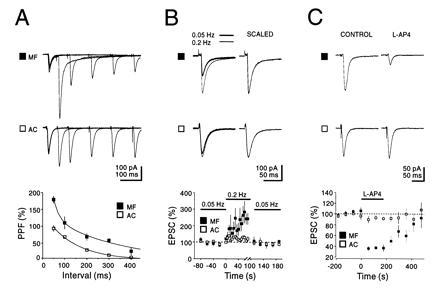Figure 1.

Physiological and pharmacological distinction between AMPA-receptor EPSCs evoked by stimulation of mossy fibers and associational/commissural fibers. (A) The mossy fiber (MF) synapse exhibits a greater paired pulse facilitation (PPF) than the assoc/com (AC) synapse. Current traces: superimposed sweeps with five different interstimulus intervals. Note the long-lasting tail, specific for mossy fiber EPSCs. This component is not due to voltage clamp error and is characterized elsewhere (P. Castillo, personal communication). The graph shows the average PPF plotted against interstimulus intervals (n = 6). The points for the assoc/com synapse were fitted with a single exponential (t = 133 ms), while the points for the mossy fiber synapses were fitted with a double exponential (t1 = 27 ms, t2 = 301 ms). PPF was defined as [(p2 − p1)/p1] × 100, where p1 and p2 are the amplitude of the EPSCs evoked by the first and second pulse, respectively. (B) Frequency facilitation of mossy fiber responses. Current traces: superimposed averaged EPSCs evoked at two different stimulation frequencies (0.05 and 0.2 Hz). The graph summarizes the results of six experiments. Note the slow build up of facilitation at the mossy fiber synapse as well as the complete reversal upon returning to the control stimulation frequency. (C) Activation of presynaptic group three metabotropic glutamate receptors by l-AP4 (10 μM) selectively depresses mossy fiber transmission. The graph summarizes the results of eight experiments. For each of the three sets of experiments in A–C the current traces shown for mossy fiber and assoc/com were recorded from the same CA3 neurons voltage clamped at −70 mV.
